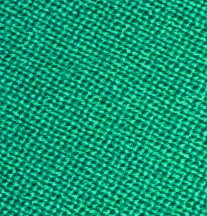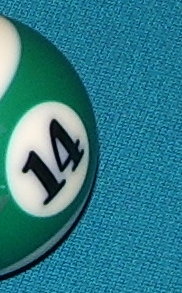Baize
This article needs additional citations for verification. (January 2011) |

Baize is a coarse woollen (or in cheaper variants cotton) cloth, similar in texture to felt, but more durable.
History[edit]
A mid-17th-century English ditty – much quoted in histories of ale and beer brewing in England – refers to 1525:
Hops, heresies, bays, and beer;
Came into England all in one year.
Heresies refers to the Protestant Reformation, while bays is the Elizabethan spelling for baize[1] (though bay and baize eventually came to describe two similar but distinguishable types of cloth, as described below).
Applications[edit]
Baize is often used on billiard tables to cover the slate and cushions, and is often used on other kinds of gaming tables (usually gambling) such as those for blackjack, baccarat, craps and other casino games. It is also found as a writing surface, particularly on 19th century pedestal desks.
The surface finish of baize is coarse, thus increasing rolling resistance and perceptibly slowing billiard balls. Baize is available with and without a perceptible nap. Snooker, in which understanding nap effects is part of the game, uses the nappy variety, while pool and carom billiards use the napless type.
For gaming use, baize is traditionally dyed green, in mimicry of a lawn (see Cue sport, "History"), though wide variety of table colours have become accepted. Bay was similar stuff to baize, but lighter in weight and with a shorter nap.[2]
Idioms and catchphrases[edit]
- "Let's get the boys on the baize!" has been a catchphrase of BBC TV snooker presenter Rob Walker since 2008.[3]
- At one time, "the green baize door" (a door to which cloth had been tacked to deaden noise) in a house separated the servants' quarters from the family's living quarters;[4] hence the phrase's usage as a metonym for domestic service. Moving men in the children's book The Railway Children wore green baize aprons.
See also[edit]
References[edit]
- ^ Marmor, Paula Kate (22 March 2008). "Good English Ale". Life in Elizabethan England. Retrieved 20 February 2011.
- ^ Montgomery, Florence M. (1984). Textiles in America 1650–1870. New York / London: Norton. p. 152. ISBN 978-0-393-01703-8 – via Internet Archive.
Heaton distinguished between bay and baize: 'the bay was light, baise is heavy and with a long nap' (Letter Books of Joseph Holroyd, p. 11n).
- ^ Reason, Mark (4 May 2008). "Ronnie O'Sullivan greater than Tiger Woods". The Daily Telegraph. Retrieved 5 May 2014.
- ^ Greene, Graham (1976) [1935]. The Basement Room. Penguin. p. 125. Also republished as The Fallen Idol.
External links[edit]
- . Encyclopædia Britannica. Vol. 3 (11th ed.). 1911.


